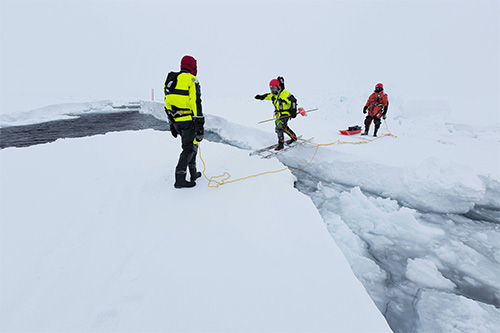
Scientists see 'new Arctic' is more prone to melting and storms
December 13, 2016
The researchers reached this conclusion after spending almost half a year, much of it on a ship frozen into the ice, as part of the first wintertime expedition to examine the younger, thinner sea ice that typifies the "new Arctic." They discussed their findings in the fall meeting of the American Geophysical Union.
Researchers on the ice.
Global warming is proving to be particularly hard on the Arctic, with late summer sea ice coverage less than half of what it was in the 1970s. While they can't specifically link their short-term observations to climate change, the N-ICE researchers worry that the reduced sea-ice coverage and thickness will lead to even more melting, the so-called "Arctic amplification." Most of the solar energy that reaches Arctic snow and sea ice gets reflected back into space. But when the snow and ice is replaced by darker, open water, most of the energy gets absorbed and in turn helps melt more ice. Now, the researchers say, what ice is left is particularly vulnerable. The thinner and younger ice works differently, said Granskog. It moves faster, breaks up more easily and is more vulnerable to winds and storms. Von Walden, a Washington State University professor of civil and environmental engineering, spent a month on the project and helped to document the first observations of how winter storms affect the surface energy balance of the young, thinner sea ice. Von Walden saw how high winds move the ice, stressing and breaking it. The winds also transport large amounts of heat and moisture. One winter storm raised the surface temperature from -40 F to 32 F in less than 48 hours, while the moisture in the air increased by 10 times. These storms also bring clouds. All of these factors significantly warm the surface at a time when there is no sunlight, he said. Amelie Meyer, an oceanographer at the Norwegian Polar Institute, saw how storms can move the ice so fast that warm, 40 F water rises tens to hundreds of feet to melt the underside of the ice. In the summer, as much as 10 inches of ice could melt in one day. At one point, the scientists saw vast stretches of ice break up in a few hours, forcing them to scramble and even wade through frozen water to retrieve their equipment. The researchers also observed the first phytoplankton bloom under snow-covered ice as additional light passing through leads, or cracks, triggers its early growth. Traditional Arctic under-ice blooms tend to sink to the deep ocean, sequestering carbon in a sort of "carbon pump." But this bloom did not sink as much as expected due to a different algae that grew in it. Such changes could have significant implications for Arctic ecology and the movement of carbon, the researchers said.
Editing by Mary Kauffman, SitNews
Source of News:
Representations of fact and opinions in comments posted are solely those of the individual posters and do not represent the opinions of Sitnews.
|
||
